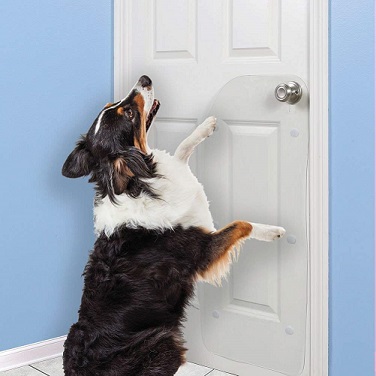
How Do I Stop My Dog From Scratching The Door?
You love your dog, but you also love your house. A scratching dog will quickly scuff and even destroy doors and door jambs. It might not sound like a big deal, but wait until it happens in your house – you will be desperate for a solution that ends this behavior.
Before you can stop your dog from scratching the dog, you need to first understand the causes or triggers of this behavior. Some of the most common triggers include;
- Boredom
- Separation anxiety
- The dog may be trying to get your attention due to various reasons
- The dog may want to go outside or come back inside the house.
To save your door; and save you the trips to the vet when your dog ingests some pieces of wood or gets splinters, I’ll share some ways to stop this problem. These tips also save you the embarrassment and trouble of having to fix the door over and over.
Training
Scratching the door for dogs can become a habit. And, there’s no better way, to change a dog’s habit than to use effective training methods. You need to train your dog to understand that doors aren’t meant for scratching. If you have a puppy, it isn’t that hard for him or her to respond positively to the training. More patience and persistence is required for older dogs, but with time, they will come around.
Dog love treats, so make sure you have a handful of them before you start the training. Other tools you may need are food puzzles and quiet rooms to carry out the training. The main types of training and prevention include;
- The Distraction method
- The Correction method
- The Calming method
- The Distraction Method
- Take your dog for a walk – Dogs love to be active most of the time. When we’re not active, all have that habit that we resort to avoid boredom. If your dog is scratching the door out of boredom, take him for a lengthy active walk. This drains all the energy out of him, with none left to destroy your doors. If long walks aren’t an option anymore, get creative. You can use the limited space by throwing discs or tennis balls and have him sprint through the field to get them.
- Dog flaps/doggy doors – This is a simple mechanism that can be placed at a door or running wall to allow a dog to go out and come back into the house freely. Some people have reservations about this technique since these flaps can allow the entry of coyotes and raccoons into the house. To avoid this, you can use and electronic flap door that allows entry only to your dog.
- Invest in anti-anxiety measure – Your dog may be scratching the door when you leave because he experiences separation anxiety and does not like to be left alone. You can also leave soft music playing in the house, or the radio. This can help calm down the dog. Pheromone dispensers are also great tools that can help to calm down your dog.
- Citronella – Pheromone dispensers calm down the dog but citronella is more of a repellent. If you spray it on the dog, you may prevent him from reaching the door. Some owners have tried spraying the door with citronella, but this method usually is not effective.
- Correction Method
This is where the room comes in. Lock your dog in the room and wait for boredom to kick in. In most cases, the dog will start scratching the door. As soon as he starts, catch him red handed and assert your authority. Do this in a firm but less frightening way. Dogs understand words like “yes” and “no’. Assert a firm “No” to make it clear that what he’s doing is wrong. The dog will eventually quit scratching the door and start seeking your affection. If he stops scratching and starts seeking your attention, you can offer a treat. With practice, the dog will eventually learn that submitting is the positive habit while scratching the door is the negative habit.
- The Calming Method
Dogs respond according to the way you treat them. Avoid too much affection when leaving, this will make the dog miss you and experience anxiety when you’re away. Teach the dog that you’re not always be there to play with him. You can do this by ignoring him when you’re in the house. This means he can develop other positive habits to keep himself busy. You can also get him toys such as food puzzles to keep him busy for the rest of the day. When you’re back, manage his excitement. If he is too excited, ignore him until he cools down. Responding with equal excitement only shows that you have missed him all day too. This makes things worse since it justifies the separation anxiety. Ignoring him for some time will help him realize that being he should always be calm, even when you’re away.
Some owners report that their dog will scratch at the bedroom door all night. These dogs are unsettled at night and want to be near their owner after dark. The best course here is to train your pup using the calming method.
It’s all about you
Through the training and prevention measures, one thing is quite clear; we are the causes to bad habits such as scratching of doors. Our dogs respond to what we’ve shown them. The energy levels they portray as we leave and as we come back, are as a result of what we’ve instilled in them. As you train your dog to stop scratching the door, deal with the underlying issue of how you treat your dog when you’re around him. I think this approach will bring better results over time.
Final Thoughts
Having a dog that scratches the door is quite annoying, that’s for sure. It leads to physical damage for your door, health damage for your dog, and affects your sanity too. It’s important to train your dog that doors aren’t meant for scratching. You can do this by giving distractions, correcting him when he starts scratching, and managing his excitement. Do not forget that the dog responds to how we behave around them. Changing our behavior positively goes a long way in reducing their energy levels. This ensures that they will stop scratching on your door as well as quit other bad habits.
| My Dog is a Robot covers the pet technology industry. Keep up with the latest news about products, services and companies in the pet tech space. | Contact Us |



